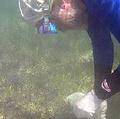 美國一名研究淺水生態系統數十年的科學家表示,世界上的海草原正慢慢消失。當這些海面下的草原消失之後,具有商業價值的貝類、魚類、水鳥和其他野生物,水質及防腐層也會漸漸消失。
美國一名研究淺水生態系統數十年的科學家表示,世界上的海草原正慢慢消失。當這些海面下的草原消失之後,具有商業價值的貝類、魚類、水鳥和其他野生物,水質及防腐層也會漸漸消失。
新罕布夏大學自然資源與海洋科學研究教授索爾特(Frederick Short)在接受克里族印地安人委託,協助族人在哈德遜灣移植日益稀少的大葉藻(eelgrass)時,發現從哈德遜灣到太平洋島國帛琉海域,都有同樣的狀況。
索爾特對這種發現於北大西洋的大葉藻已研究有20多年之久,並在2001年發起成立「海草原網」(SeagrassNet)全球監測計畫,他說:「我們所監測的每一處海草原,幾乎都在消減當中。」儘管目前全球評估結論尚未出爐,但他認為人為衝擊因素是主要原因。
海草屬開花植物,其根莖系統有穩定沈積物的作用,能保護海岸線免於洋流以及氣候相關作用力造成的侵蝕。此外,海草也可有效過濾營養物及微粒,而且是碎屑食物鏈(detrital food chain,為魚類及貝類的食物來源)的根基。
衛星影像顯示出調查結果指出衝擊起因不是全球效應,如氣候變遷所造成的影響,而是岸邊伐木增加了相當程度的海岸漂流物堆積於兩岸邊,減少海草原底部成長所需的光透度。
索爾特等研究人員認為,不排除全球氣候變遷為海草原減少的因素之一,但海草原減少的原因似乎更有可能是地方性問題。他說:「人為造成的水污染是最大的問題」。
當海草原的消失影響甚鉅。在泰國,「海草原網」的研究人員開始對2004年12月地震引發的大海嘯對海草原的影響做調查。索爾特指出,由於海床提供當地漁民最有價值的貝類作物,「如果海草原消失,那麼人類所需的蛋白質來源亦同消失。」
Around the world, seagrass beds are in decline, says a scientist who has been studying the shallow water ecosystems for decades. As these underwater meadows disappear, so do commercially valuable shellfish and fish, waterfowl and other wildlife, water quality, and erosion prevention.
"Almost everywhere we start monitoring seagrass, it's declining," he says. While conclusive global results are not yet available, Short believes human impact is responsible for the decline. Short, who founded the global monitoring program SeagrassNet in 2001, has been studying eelgrass, a type of seagrass found in the Northern Atlantic, for more than 20 years.
The root and rhizome system of these flowering plants stabilizes sediments, protecting the coastline from currents and weather-related erosion. Seagrass is an effective filter of nutrients and particulates, and it is the basis of a detrital food chain that feeds fish and shellfish.
Satellite imaging showed researchers that the impact was not due to a global force like climate change, but rather to on-shore logging that had increased the level of water-borne sediments at both sites, decreasing light reaching the bottom, where seagrasses grow.
Short and his SeagrassNet colleagues have not ruled out global climate change as a factor in the decline of seagrass beds. But the reasons for seagrass declines appear to be more localized. "Human pollution of the water has been the biggest issue," he says.
When seagrass beds disappear, Short says, the impact is major. In Thailand, where SeagrassNet researchers have begun investigating the impact of the December 2004 tsunami on seagrass, the beds provide local fishers with significant shellfish. "If the seagrass beds disappear, so do the people's protein sources," says Short.


